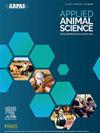Substitution of modified distillers grains with soybean meal with or without soyhulls had negligible effects on growth performance, efficiency, and carcass traits in yearling beef steers
IF 1.5
Q3 AGRICULTURE, DAIRY & ANIMAL SCIENCE
引用次数: 0
Abstract
Objective
The objective of this study was to evaluate animal performance, carcass traits, and dietary net energy utilization in finishing beef steers when soybean meal (SBM) with or without soybean hulls (SBH) replaced modified distillers plus solubles (MDGS).
Materials and Methods
Predominately Angus steers (n = 240; initial shrunk BW = 435 ± 23.2 kg) were allotted to 1 of 24 pens. Steers were blocked by location within the feedlot and randomly assigned to 3 treatments: MDGS fed at 15% diet DM (MDGS) replaced by either soybean meal and corn (9 and 6% of DM, respectively; SBM), or soybean meal and soyhull pellets (9% and 6% of DM, respectively; SBM-SBH). Growth performance was calculated on a carcass-adjusted basis (hot carcass weight/0.625). Data were analyzed as a randomized complete block design with random effect of block and fixed effect of treatment; pen was the experimental unit. Orthogonal contrasts were used to determine the effects of protein source (MDGS vs. SBM and SBM-SBH) or starch compared with NDF (SBM vs. MDGS and SBM-SBH). Steers were fed for 118 d until shipped for slaughter at a commercial abattoir where carcass data and liver abscess scores were collected.
Results and Discussion
No differences among treatments (P ≥ 0.11) were observed for carcass-adjusted final BW, DMI, ADG, or G:F. Dietary treatment did not affect (P ≥ 0.11) carcass measurements and distributions of USDA Quality or Yield grades were unaffected by treatment (P ≥ 0.39). Dietary treatment did not affect liver abscess prevalence or severity (P = 0.11). Net energy values calculated from animal performance agreed closely with tabular estimates.
Implications and Applications
Steers fed MDGS as the supplemental protein source did not demonstrate a performance advantage compared with those fed SBM- based protein supplements, despite the enhanced diet conditioning attributes and greater RUP concentrations provided by MDGS.
用含或不含豆粕的豆粕替代改性酒糟对一岁肉牛的生长性能、效率和胴体性状的影响可以忽略不计
目的研究添加或不添加大豆壳的豆粕(SBM)替代改性酒糟加可溶性物(MDGS)对育肥牛的动物生产性能、胴体性状和饲粮净能量利用的影响。材料与方法以安格斯阉牛为主(n = 240;初始收缩体重= 435±23.2 kg)分配给24只笔中的1只。在饲养场内按位置分组,随机分配给3个处理:以15%的日粮DM (mdg)喂养的mdg,分别用豆粕和玉米(分别占DM的9%和6%)替代;豆粕和豆壳颗粒(分别占DM的9%和6%;SBM-SBH)。生长性能按胴体调整后计算(热胴体重/0.625)。数据采用随机完全区组设计,区组随机效应,治疗固定效应;Pen是实验单位。采用正交对比法确定蛋白质来源(mdg vs. SBM和SBM- sbh)或淀粉与NDF (SBM vs. mdg和SBM- sbh)的影响。饲喂肉牛118 d,直到运往商业屠宰场屠宰,在那里收集胴体数据和肝脓肿评分。结果与讨论经胴体校正的最终体重、DMI、ADG或G:F在处理间无差异(P≥0.11)。饲粮处理不影响胴体尺寸(P≥0.11),USDA品质或产量等级分布不受处理影响(P≥0.39)。饮食治疗对肝脓肿患病率和严重程度没有影响(P = 0.11)。根据动物生产性能计算出的净能值与表格估算值非常吻合。尽管mdg提供了增强的饮食调节属性和更高的RUP浓度,但与以SBM为基础的蛋白质补充剂相比,mdg作为补充蛋白质来源的阉牛没有表现出性能优势。
本文章由计算机程序翻译,如有差异,请以英文原文为准。
求助全文
约1分钟内获得全文
求助全文

 求助内容:
求助内容: 应助结果提醒方式:
应助结果提醒方式:


